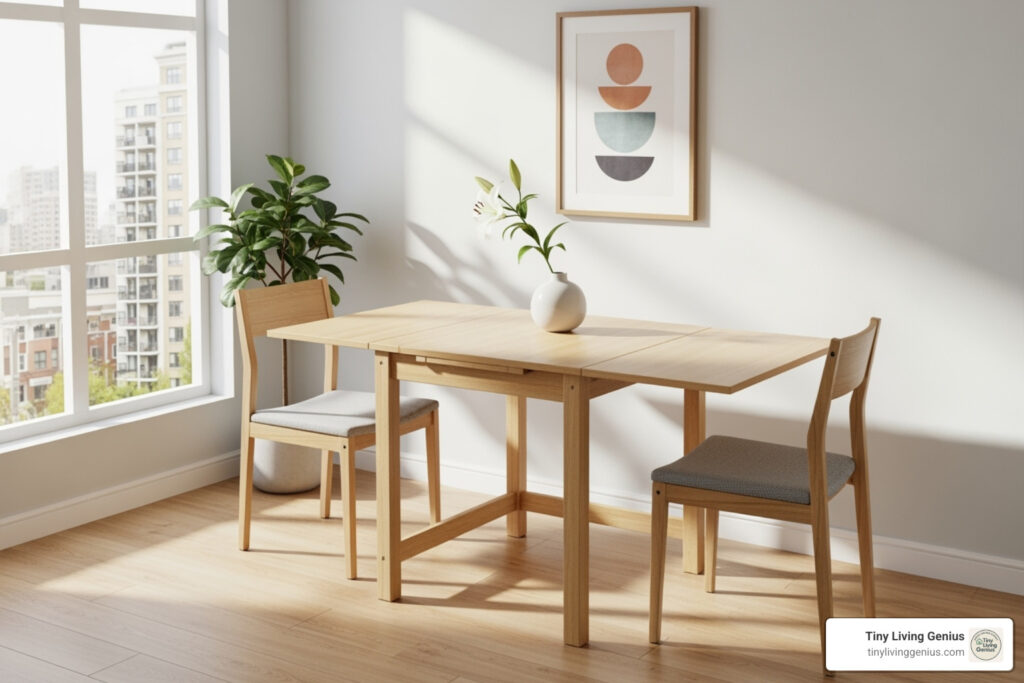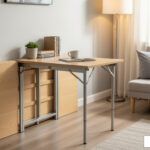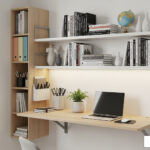Dining table small area: 4 Essential Hacks!
Why the Right Dining Table Small Area Solution Changes Everything
Finding the perfect dining table small area setup doesn’t have to be complicated. Here’s what you need to know right away:
Best Dining Table Options for Small Areas:
- Drop-leaf or extendable tables – Expand when you need them, fold down when you don’t.
- Round or square tables – Improve traffic flow and fit neatly in tight corners.
- Wall-mounted fold-down tables – Maximum space-saving for tiny kitchens.
- Pedestal base tables – No corner legs means easier movement and more legroom.
- Multi-functional tables – Double as a desk, prep surface, or storage solution.
Key Measurement: Allow at least 30-36 inches of clearance around your table for comfortable seating and movement.
In a small apartment or studio, every piece of furniture must earn its place. The right dining table can transform a cramped corner into a functional, stylish space where you want to spend time. It’s not about settling for less—it’s about choosing smarter. The difference between a dining area that feels claustrophobic and one that feels just right often comes down to the table’s shape, size, and placement.
I’m Ramy Saber, founder of Tiny Living Genius. As a Civil Engineer, I’ve spent years researching and testing furniture solutions for compact living. Through hands-on experience helping people maximize their small spaces, I’ve learned what truly makes a difference when square footage is limited.
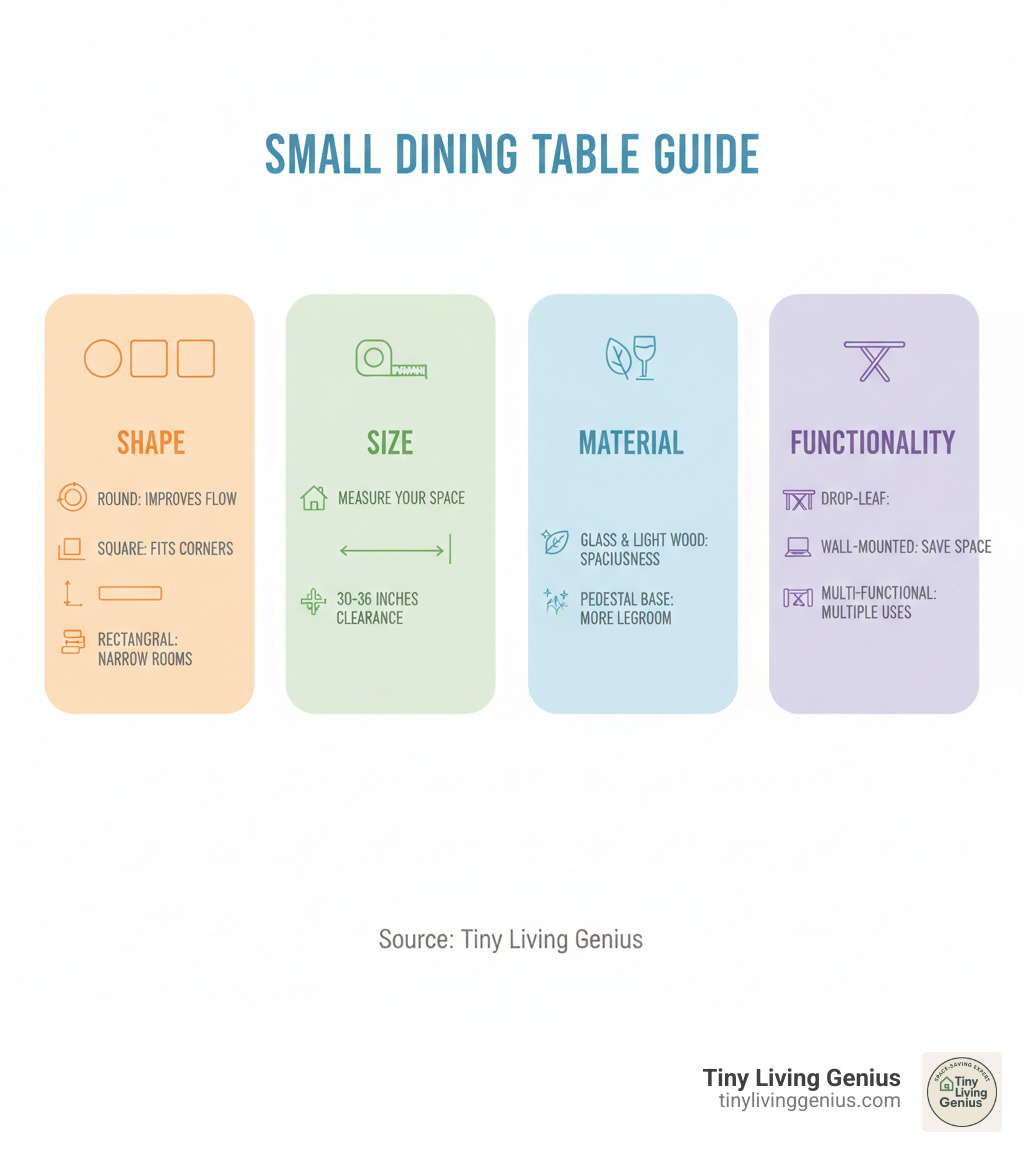
Choosing the Right Foundation: Shape, Size, and Placement
Getting your dining table small area right starts with three essential decisions: shape, size, and placement. These choices determine whether your dining space feels cozy or cramped.
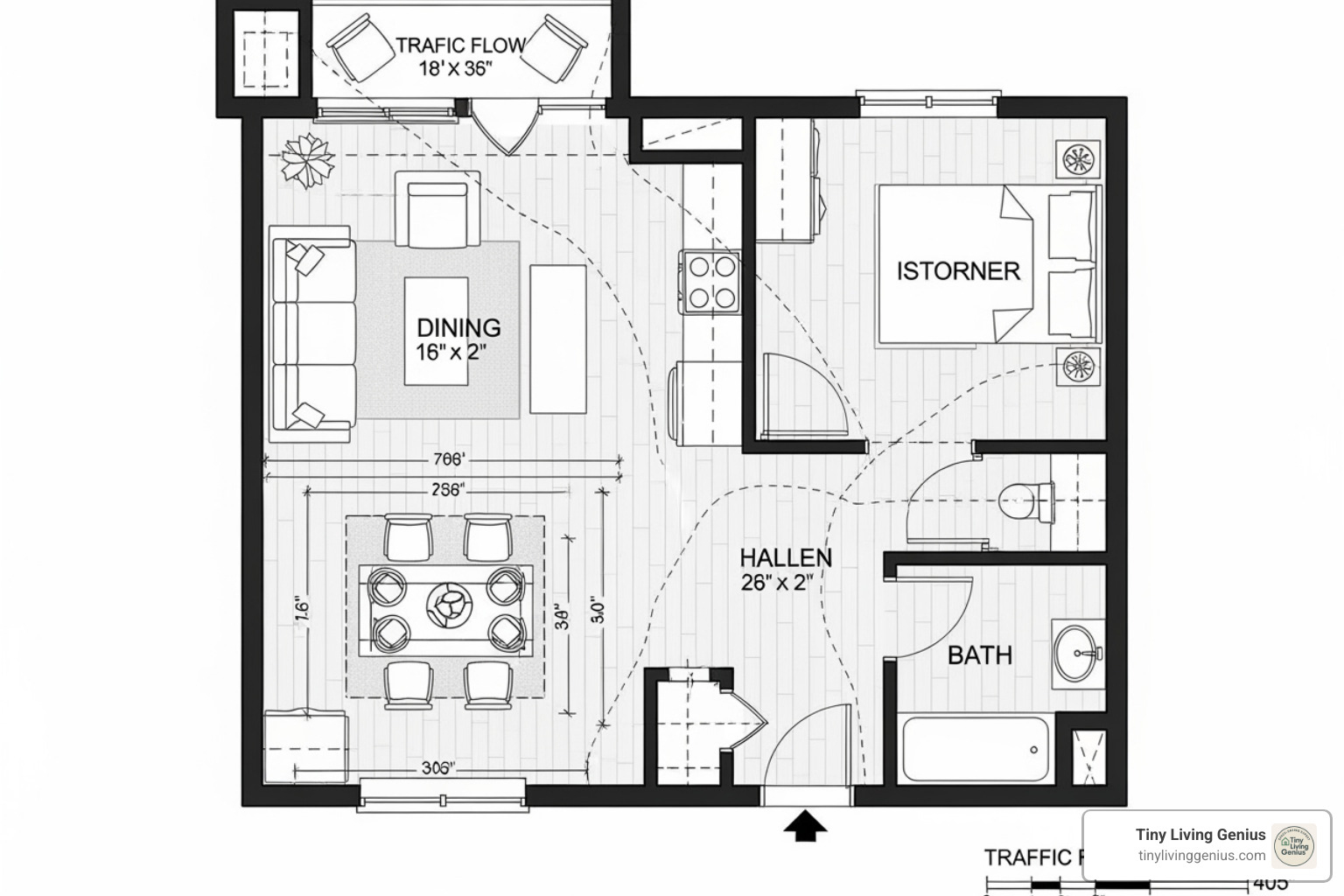
Before you fall in love with a table, grab a tape measure. The most critical rule is to allow at least 30-36 inches of clearance between the table’s edge and any walls or furniture. This buffer is non-negotiable for pulling out chairs and walking around comfortably. Forgetting this step is the number one mistake people make, leading to a dining area that’s a daily frustration.
For more detailed guidance on selecting furniture that truly works in compact spaces, check out our How to Choose the Right Furniture for Your Small Space: A Comprehensive Guide.
How Table Shape Impacts Your Space
The shape you choose fundamentally changes how your small dining area functions.
- Round tables are excellent for traffic flow, as there are no sharp corners to bump into. They create an intimate feel that encourages conversation. A 36-inch round table can comfortably seat four.
- Square tables are masters of efficiency, especially when tucked against a wall or into a corner. They’re perfect for one or two people daily and can be pulled out for guests.
- Rectangular tables work best in long, narrow rooms. Look for narrower models (28-30 inches wide) to preserve walking space.
- Oval tables offer a hybrid solution, combining the linear seating of a rectangle with the soft, space-saving corners of a round table.
Another game-changer is the pedestal base. By eliminating corner legs, these tables provide more legroom and make it easier to slide chairs in, creating a cleaner, less cluttered look.
Common Mistakes to Avoid
Even with the best intentions, it’s easy to make choices that backfire. Here are the pitfalls to avoid:
- Ignoring traffic flow: You need that 30-36 inch clearance. Without it, you’ll spend months bumping into furniture.
- Choosing a table that’s too large: A table that dominates the room makes the entire space feel suffocating, even if it technically fits.
- Forgetting about chair space: Ensure there’s room to pull chairs out without hitting walls. Look for compact dining sets where chairs tuck completely under the table.
- Overlooking visual weight: A dark, bulky table can feel overwhelming. Opt for lighter materials like glass or light-colored wood, slender legs, and open designs.
- Using oversized chairs: Stick with armless chairs, benches, or stools that can disappear under the table when not in use.
Avoiding these mistakes makes a huge difference. For more creative solutions designed for compact living, explore our Creative Furniture Solutions for Small Spaces.
The Best Types of Dining Table for Small Area
When square footage is limited, your furniture needs to be smart. The best dining table small area solutions are designed to transform, tuck away, or serve multiple purposes. These pieces prioritize space-saving features, functionality, and adaptability.
If you’re intrigued by furniture that can fold away, you’ll find more inspiration in our article on 10 Foldable Furniture Ideas for Small Apartments.
Drop-Leaf & Extendable Tables: The Versatile Choice
Drop-leaf and extendable tables are like having two tables in one—compact for daily life, yet ready for guests. This flexibility is invaluable in small homes.
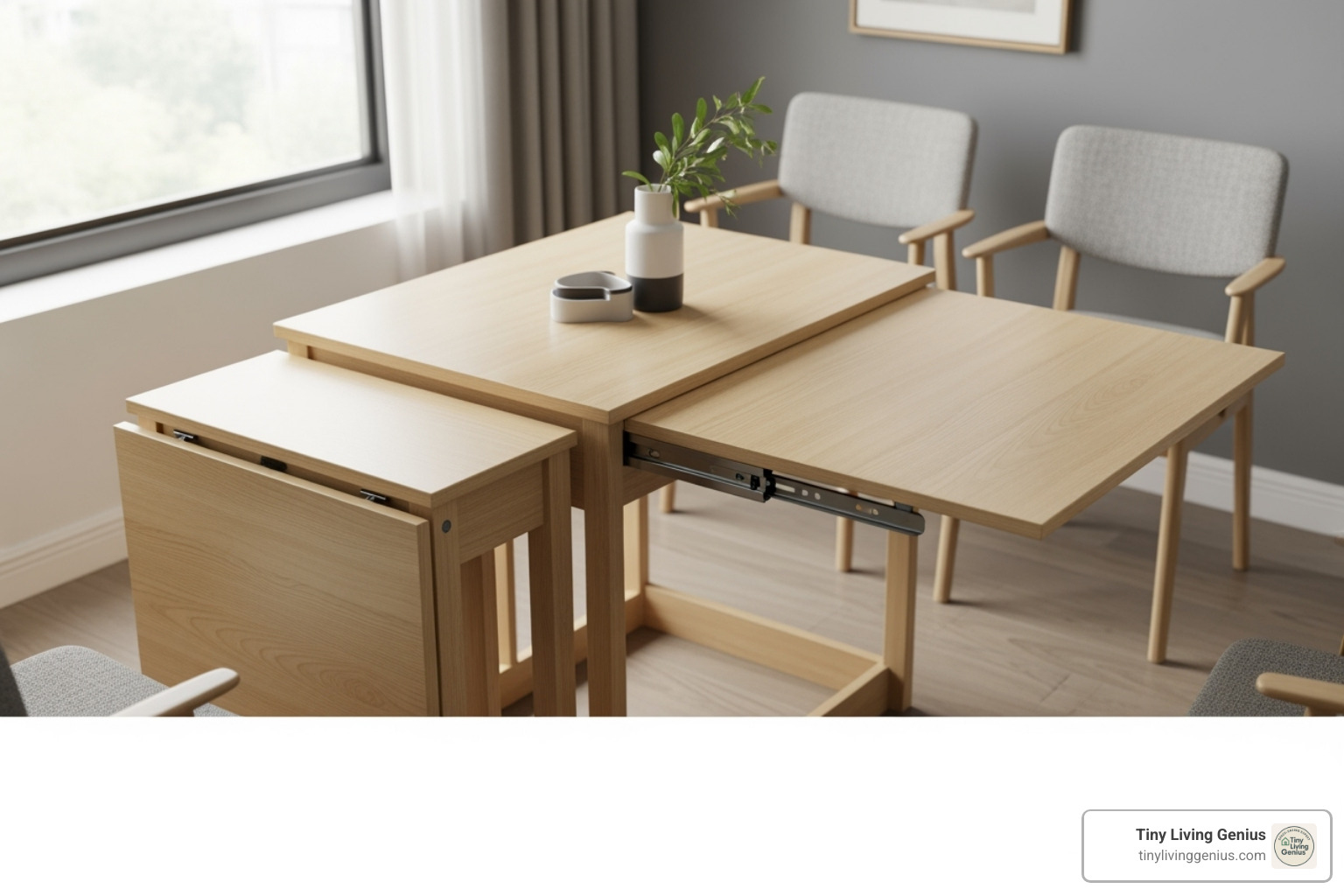
- Drop-leaf tables have hinged sections that fold down. Many include built-in storage, adding another layer of function. When folded, they can sit neatly against a wall.
- Gateleg tables are a variation where hinged “gates” support the leaves, allowing them to collapse to a very narrow profile.
- Extendable tables typically use a central leaf (sometimes stored within the table, known as a butterfly leaf) to lengthen the surface, changing an intimate table for two into a dinner party setup for six or more.
These designs are ideal for studio apartments where a dedicated dining room isn’t an option. This classic drop-leaf design is a practical, well-made piece that proves you don’t have to sacrifice quality in a small space.
Wall-Mounted & Built-In Tables: The Ultimate Space-Savers
If floor space is your most precious commodity, why use it for table legs? Wall-mounted and built-in tables offer a transformative approach.
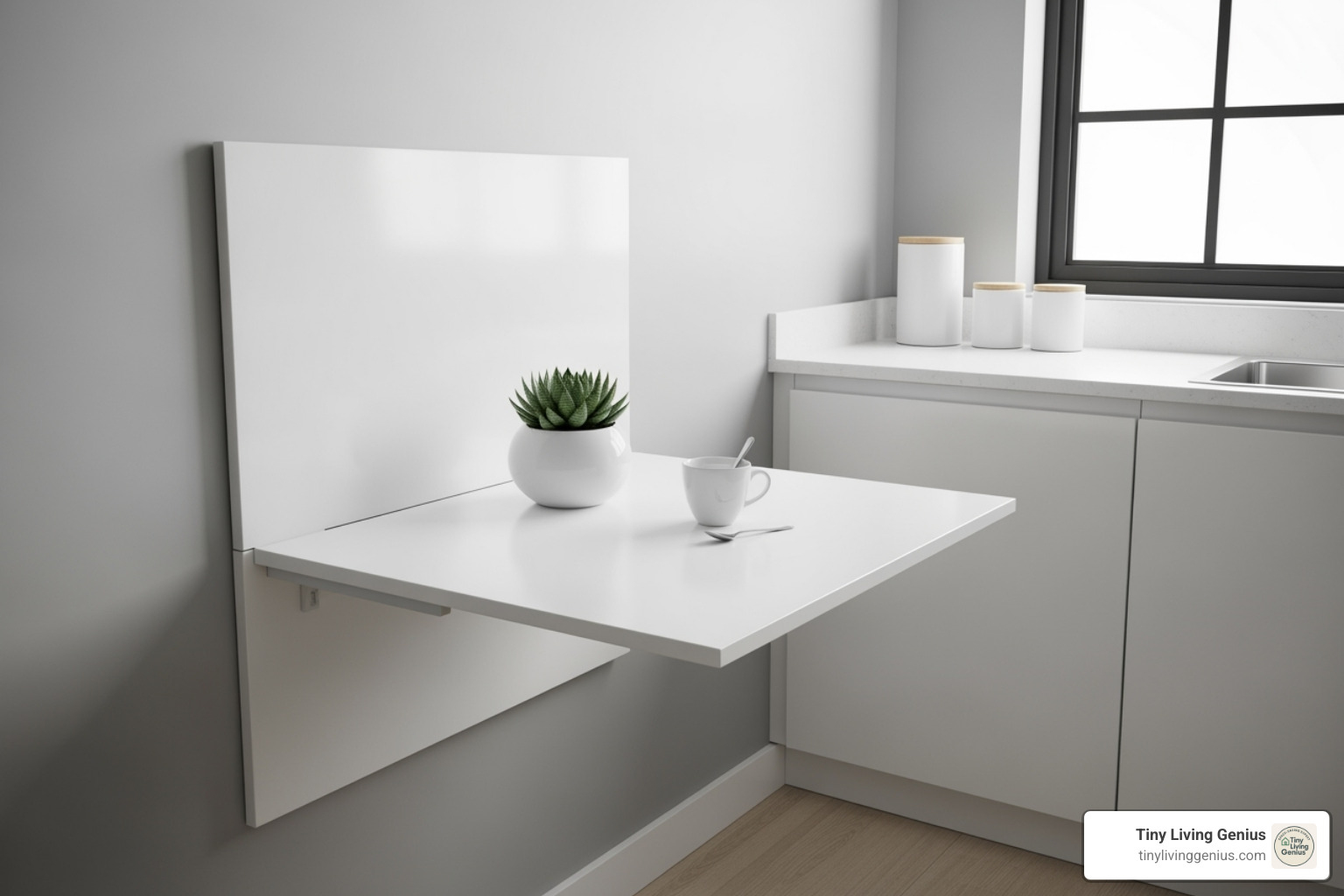
Wall-mounted fold-down tables attach directly to your wall and fold flat when not in use. When it’s time to eat, you flip the surface down; when you’re done, it disappears, leaving your floor space completely clear. This makes a tiny kitchen or studio feel much more spacious.
Built-in tables, like banquette seating, become part of your home’s architecture. A built-in bench along a wall, often with hidden storage underneath, eliminates the need for chairs on one side and makes use of awkward corners. These solutions free up floor space and make a room feel more open. For more ideas on integrating furniture into your home, see our guide on Tiny Home Furniture.
Multi-Functional Tables: The Smart Solution
In small homes, the best furniture does more than one job. A multi-functional dining table small area setup can be your breakfast spot, home office, and dinner table all in one.
- Tables with integrated storage, like shelves or drawers, keep placemats, cutlery, or office supplies handy but out of sight.
- Kitchen island combinations blur the line between cooking and dining. An island that extends to include a dining surface creates a cohesive, multi-use zone for prep, casual meals, and homework.
- Counter-height tables (34-36 inches tall) double as extra prep surfaces. They create a casual, contemporary feel and draw the eye upward. Stools can often be tucked completely underneath, saving valuable floor space.
These multi-talented pieces are perfect for open-plan living. For more inspiration, explore our article on Creative Ideas for Small Space Furniture: Maximizing Functionality.
Clever Design: Materials and Decor to Improve Your Space
Once you’ve chosen the size and shape for your dining table small area, the right materials and decor can make the space feel larger. The secret is creating “visual lightness” with elements that feel open, bright, and airy.
For more insights on how design transforms small living areas, take a look at our guide on Efficient Design for Small Spaces: Stylish Living Solutions.
Materials and Designs That Feel Lighter
The materials of your table can make your room feel twice as large.
- Glass, acrylic, or lucite tabletops are champions of creating space. Because you can see through them, they don’t block sightlines, making a room feel open and airy.
- Light-colored wood in natural or white-washed finishes reflects light and keeps the space feeling bright. Dark woods tend to absorb light and can make a small room feel more closed in.
- Reflective metal finishes like chrome or polished brass bounce light around the room, adding dimension without feeling heavy.
Table design is just as important. Look for minimalist designs with clean lines, slender legs, or a pedestal base. A table on a single central pedestal looks lighter and provides more flexibility for seating.
Using Decor to Maximize a dining table small area
Your decor choices can amplify the sense of spaciousness.
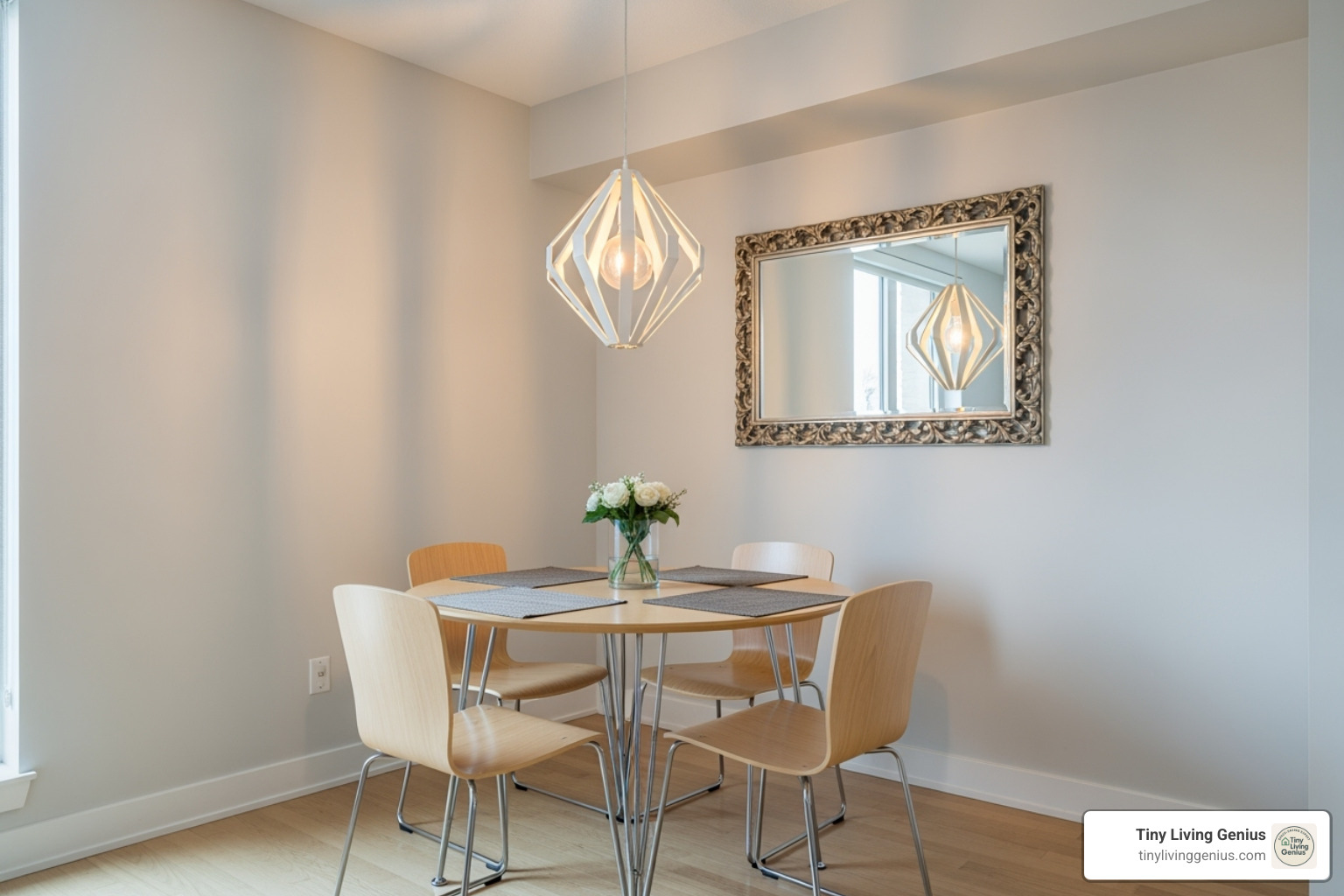
- Strategic mirror placement is a classic trick. Hanging a large mirror on a wall near your table can seemingly double the size of the room by reflecting the space.
- Pendant lighting provides focused light and visually defines the dining zone without physical barriers. It also draws the eye upward, making the ceiling feel higher.
- Smart seating is crucial. Armless chairs slide completely under the table, freeing up floor space. A bench against a wall has a streamlined look and often includes hidden storage. For counter-height tables, stools that tuck away are a fantastic, space-saving option.
Combining a thoughtfully chosen table with these decor strategies can turn even the smallest corner into a welcoming, functional dining space.
Frequently Asked Questions about Dining Tables for Small Spaces
Navigating the options for a dining table small area can be tricky. Here are quick answers to the most common questions we receive.
What is the best shape for a dining table in a very small room?
Round or square tables are often your best bet. Round tables are forgiving because they lack sharp corners, which improves traffic flow and makes a space feel less cluttered. Square tables are highly efficient when placed against a wall or in a corner, making them ideal for one or two people while still being available to pull out for guests.
How much space do you need around a dining table?
This is the most important rule: allow at least 30-36 inches of clearance space between the table’s edge and any walls or other furniture. This isn’t just a suggestion; it’s essential for comfortably pulling out chairs and allowing people to walk past, even when someone is seated.
Can a dining table for a small area still seat four people?
Yes, absolutely! A small space doesn’t mean you have to sacrifice hosting. A 36-inch round table can comfortably seat four. Extendable or drop-leaf tables offer the flexibility to expand for guests. To maximize seating, choose a table with a pedestal base to eliminate corner leg obstructions and pair it with armless chairs or a compact bench.
Conclusion
Finding the perfect dining table small area setup is about creating a space you love to use. We’ve covered the essentials: measuring for 30-36 inches of clearance, choosing smart shapes like round or square tables, and embracing versatile designs.
Drop-leaf, wall-mounted, and multi-functional tables prove that you don’t need a large room to have a functional dining area. By selecting materials that create visual lightness—like glass or light-colored wood—and using decor strategically, you can make your dining zone feel intentional and inviting, not cramped.
Living in a small space doesn’t limit your style. It’s about making thoughtful choices where every piece is both beautiful and useful. At Tiny Living Genius, we know that getting your dining area right can change how you feel about your entire home.
You now have the knowledge to choose a table that works for you, whether it’s a flexible drop-leaf, a space-saving wall-mounted design, or a chic round pedestal table. Trust your measurements, think creatively, and create a space you’ll enjoy every day.
Ready to continue changing your compact living space? Explore more space-saving furniture solutions and see how Tiny Living Genius can help you make every square inch of your home work harder and look better.

